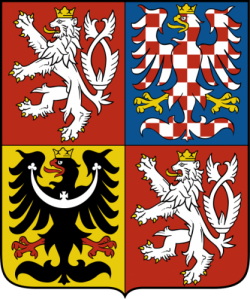Coat of arms of the Czech Republic

The coat of arms of the Czech Republic (Czech: Státní znak České republiky) displays the three historical regions—the Czech lands—which make up the nation.
The arms of Bohemia show a silver double-tailed lion on a red background. The Bohemian Lion is repeated in the lower-left-hand side of the coat of arms (from the perspective of the person holding the shield). The Moravian red-and-silver chequered eagle is shown on a blue background. Since the days of the Habsburg Monarchy until 1918, the Moravian Eagle was chequered in the red-and-gold colors of the Habsburg dynasty. The arms of Silesia are a black eagle with the so-called "clover stalk" in her breast on a golden background, although only a small south-eastern part of the historical region (Czech Silesia) belongs to the Czech Republic.
The history of the Czech coat of arms dates back to the 13th century, when the Bohemian Lion, a meed by Emperor Frederick Barbarossa to King Vladislaus II of Bohemia, appeared on the seal of his Přemyslid descendant King Ottokar II (1253-1278). The Moravian Eagle was first documented on the seal of Ottokar's uncle, Margrave Přemysl (d. 1239). The shields also appeared on the coat of arms of the Lands of the Bohemian Crown established by Emperor Charles IV. The Silesian Eagle stems from the ruling dynasty of the Piasts and was first applied by Duke Henry II the Pious (1238-1241).
© Symbols.com
